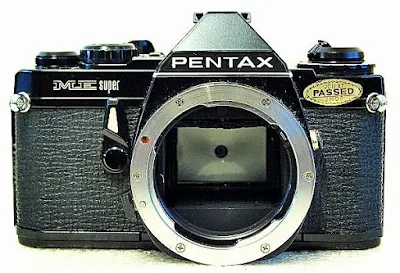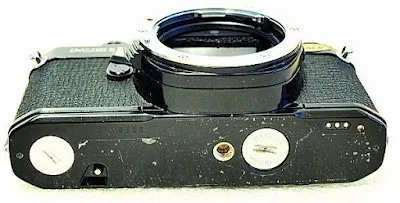The Pentax ME Super, a very compact and rather unique camera, is a highly successful 35 mm single-lens reflex camera produced by Pentax of Japan between 1979 and 1984. The camera was an update of the initial Pentax ME model, a semi-automatic aperture-priority camera launched as part of the Pentax M series. As an update, the ME Super comes with an addition of a hot shoe and a fully manual shooting mode. The camera was launched together with a lower-specification Pentax MV, a short-lived model quickly replaced by the Pentax MV1.
Without belittling its form factor, the ME Super is a full-fledged 35mm full-frame camera and a very successful one at that. The camera is fitted with a vertical-travel metal curtain electronic focal plane shutter that operates with an electronically-controlled shutter speed range from 4 seconds to 1/2000 second, and Bulb. Flash sync speed is at 1/125 second. The camera accepts film with a speed range from ISO 12 to 1600 and is also fitted with a manual control 10-second delay self-timer.
Exposure metering, activated by a slight touch of the shutter button, is center-weighted TTL (Through-the-Lens) with a metering range from EV 1 to EV 19 (ISO 100 with 50mm F1.4 lens), with exposure compensation scaled at 4X, 2X, 1X, 1/2X, and 1/4X, with X indicating the exposure increase or decrease factor. The camera is also capable of being used with a mechanical 1/125 second shutter speed without battery power, or when the batteries are depleted.
Introduction to the ME Super, Video 1 of 2
After the ME, Pentax released the ME Super as an entry-level SLR. Better than the ME and MV, the ME Super had the option for manual camera use. The function ...
Iteration-wise, there was also the ME Super SE, sold only in chrome, that came with the SE marking and a diagonal split-image microprism in the focusing screen.
Basic Camera Features
Available in both black and chrome, the Pentax M series has a form factor that is even smaller than the Olympus OM series cameras and was designed to be used with K-mount bayonet lenses, or 'PK mount', used by all Pentax 35mm cameras since 1975, and digital SLRs as well as the MILC Pentax K-01.On the very simple front, with the lens mount housing almost oversizing the rest of the camera body, are the lens release button located on the vertical of the mount at its lower corner, the self-time lever up the body towards the top plate, and on the right vertical of the mount housing, the PC sync socket.
The top of the camera is where most of the controls are. On the left end (looking down with the camera facing forward) is the film rewind crank, which also works as the pull-up film back and film canister release, integrated with the exposure compensation dial, and the pull-up and turn the crown film ISO speed selector. The pentaprism hump, slightly off-center to the left of the body, is fitted with a built-in hot shoe.
Within the cluster on the right of the top plane are the Up and Down shutter speed selector buttons, the cable-socketed shutter release button surrounded by the button-released Exposure Mode selector dial with settings for Lock, Auto mode, Manual mode, 125X flash sync, B.
Towards the right end of the top plane is the frame counter window, with the film forward lever aft of it, and the small shutter cock indicator just above the thumb rest of the lever.
On the back of the top plane are the viewfinder eyepiece and film indicator window. On the lower part, the hinged interchangeable film back fits right across the film box and comes with a memo holder.
Located on the bottom plate of the camera are (from left to right) the Winder ME/Winder ME II coupling cover, film rewind release, tripod socket, battery chamber cover, and electrical contacts for the winder.
The film box is a standard configuration as seen on most SLR film cameras of that era, with the film canister chamber on the left end of the body, followed by the shutter window, sprocket gear, and multi-pin take-up spool on the opposite end of the film box.
Film Loading and Rewinding
Film loading is the standard manual procedure of opening the film back, placing the film canister into the canister chamber, pulling the film tab across the film box, inserting the film tab end into one of the slots of the take-up spool, and tensioning towards the inner side of the take-up spool. Ensure that the film edge perforations are aligned with the sprocket gear before closing the film back. The film is wound emulsion side up.Do the mandatory two blank shots to bring the unexposed part of the film properly to Frame 1. To rewind, press the film rewind release button located on the bottom plane of the camera, and turn the film rewind crank in the clockwise direction until the film is completely rewound before taking the film canister out and sending it for processing.
Viewfinder Readout
The ME Super is fitted with a non-interchangeable split-image/microprism focusing screen with 92% coverage of the image area.Shutter speed LEDs are displayed in 2 colors - Green LEDs for speeds 1/60 to 1/2000 second, and yellow for camera shake warning for shutter speeds from 4 seconds to 1/30 second. LEDs for exposure compensation warnings, under, and over-exposure warnings are in Red.
Manual and flash settings are indicated by a continuous or flashing Green 'M', and autoflash sync is indicated by a Green LED at 125X.
Noteworthy
When the camera is set to manual shooting mode, i.e., when aperture-priority automation is disabled, these two buttons are used to set the shutter speed manually.
Another handy feature is the shutter cock indicator, a small-sized circular opening located on the top plane of the camera just above the thumb rest of the film forward lever. When the film frame is fully forwarded, and the shutter cocked, the indicator will turn from black to red, and back to black again once the shutter is released.
As with some other M series cameras, the ME Super is also fitted with a film indicator window located on the back of the top plane just below the film forward lever.
The window is to indicate that the film has been loaded properly and is moving freely when cranked forward.
Aperture Priority Shooting
When using the standard Auto shooting mode offered by the camera, the variable that is changed is the shutter speed, which is set automatically to the measured exposure value of each image frame.Changes in the ambient light condition will be reflected by a change to the shutter speed set by the camera.
With the lens wide open, however, you are limited by a very shallow depth of field, i.e., the distance between the closest and farthest objects in a photo that appears acceptably sharp. The visual you see through the viewfinder may not be true of the captured image, as it would normally be taken with the lens stopped down, and the depth of view extended to the lens aperture setting...
Manual Shooting Creatives
In manual shooting mode, activated when the Exposure Selector dial is set to M, exposure reading is done by either varying the shutter speed setting or the lens aperture opening.With the camera on a fixed shutter speed setting, vary the lens aperture opening to achieve the same.
This is the way to go into the creative aspects of your picture-taking, use the ME Super with the lens set to its widest aperture for action sports or good bokeh shots, or with the shutter speed set to the lowest possible (either handheld or secured on a tripod) low-light photography, long exposure, or just doing whatever comes to mind.
Self-Timer
The self-timer is activated by rotating the self-timer lever in the anti-clockwise direction, and the delay is actuated by slightly nudging the lever upward. When using the self-timer, it is best to cover the viewfinder eyepiece to stop stray light from leaking onto the image.Battery
The electronic system of the ME Super is powered by a pair of LR/SR44 cell button batteries for both Auto and Manual exposure modes. Low battery power is indicated by flickering LEDs in the viewfinder.Camera Body Weight
The body weight of the ME Super is 445 grams without batteries.In Use
The lightweight Pentax ME Super is fun and easy to use. Mounting it with equally lightweight SMC Pentax-M lenses will not burden you at all in the weight division, and with a very compact form that is equally easy to handle, it the worth keeping is all yours to have.The ME Super is also a robust and well-designed camera. On the 40-year-old unit I was reviewing, the camera was still going strong, the film wind was still smooth as silk, and shutter actuation and mirror flap were crisp and sharp as ever. I had a good time with the camera, putting it through its paces and all other things relevant, and at the end of the day, thoroughly pleased.


























No comments:
Post a Comment